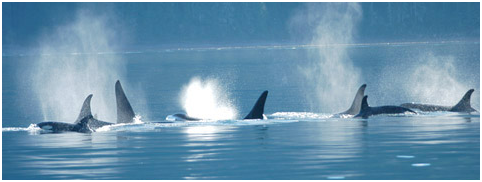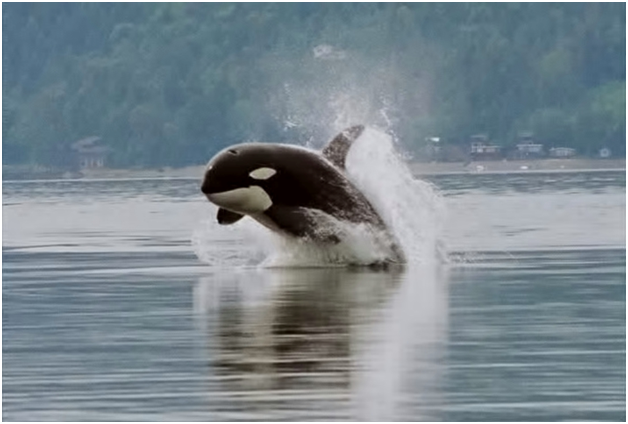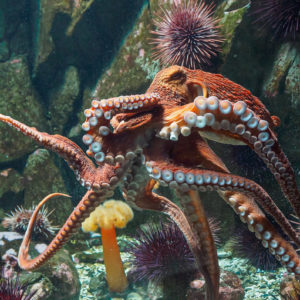Orca: Top Ocean Predator
[separator headline=”h3″ title=”What makes Orcas the top ocean predator?”]

Valerie Assinewe,Professional Writing Program Intern
Sailors who witnessed killer whale attacks of larger cetaceans named them “whale killers.” The name eventually changed to “killer whales.” With the recent realization that they do not attack humans, and they live in highly co-operative social groups, they are more often called “Orcas”—a derivative of their scientific name, Orcinus orca.
[separator headline=”h3″ title=”Adaptation to hunting in the ocean”]
Odontoceti (toothed whales), which include Orcas, and the Mysticeti (baleen whales) are grouped under the order Cetacea. Cetaceans share the following characteristics: they have a streamlined body shape; paddle-shaped front limbs; internal vestigial hind limbs; no external digits or claws; tail flattened laterally bearing horizontal flukes at the tip; vestigial ear pinnae; hairless body; thick subcutaneous blubber layer filled with fat and oil; telescoped skull bones; external nares (blowhole) on the top of the head; addition of compressed vertebrae; shortening of the neck; lack of sweat glands; internal reproductive organs; 3-chambered stomach; and an airway reinforced with cartilage to the alveoli. Many of these are adaptations for fast swimming to catch prey.
Adult males may reach lengths of 9.8 m and weigh as much as 10000 kg. Adult females may grow to 8.5 m and weigh up to 7500 kg. The Orcas that frequent Canadian oceans are typically smaller than these maxima. Compare this to an adult male human who is 176 cm and weighs 80 kg. The size of Orcas contributes to their status as apex predator—they are at the top of the food chain on which no other creature predates.
Odontocetes have a fatty organ called a melon on the forehead that focuses and directs sound waves—an acoustical lens. As the whales do not have external ears, sound channels to the inner ears using specialized “acoustic fats,” which are found in the hollow lower jaws and lead to the acoustic funnel of the ears. Odonocetes perceive ultrasounds up to 120000 Hz. This is a hunting advantage in an aquatic environment, which is often turbid. This hearing range far exceeds human capability: the hearing range in humans is 20-20000 Hz.

by Lance Barrett-Lennard
[separator headline=”h3″ title=”How fast are Orcas?”]
As a dominant predator in the oceans, Orcas have to move fast. If they need to, they can perform short, intense spurts of speeds up to 50 km/h. However, they typically cruise at around 6 km/h. If they are travelling in a hurry, they may travel at 15 km/h. In comparison, a marathon runner can run at 20 km/h and a cheetah, the fastest land animal, can run at speeds of 120 km/h.
[separator headline=”h3″ title=”Where are they?”]
Orcas inhabit all oceans of the world. Next to humans, Orcas are the most widely distributed mammal.
Orcas tolerate wide ranges of salinity, temperature and turbidity though they favour cooler waters as they are most numerous in the Arctic, the Antarctic, and areas in nutrient-rich cold water upwelling. They primarily inhabit the continental shelf in waters less than 200 m where the prey live. Seasonal pack ice limits their distribution in cold waters.
In Canada’s oceans, there are five populations of Orcas:
-

Orca porpoising
Northwest Atlantic / Eastern Arctic: The population is in the north Atlantic, an expanding range into the eastern Arctic, and recently occur more frequently in Hudson Bay with the decline of summer sea ice. They feed on marine mammals and fish.
- Transient: Found throughout the coastal waters of British Columbia where they feed on marine mammals, such as seals and sea lions.
- Northern resident: Occurs from central Vancouver Island north to southeastern Alaska in summer and fall where they feed on fish, particularly Chinook and Chum Salmon. Northern residents may range widely at other times of year.
- Southern resident: Found around southern Vancouver Island in summer and fall where they feed on fish, particularly Chinook and Chum Salmon. In other times of the year, they may range more widely.
- Offshore: Observed travelling widely in coastal waters where their feeding habit is unknown.
The “wolves of the sea” fame is from their pack behavior especially in attacking whales of larger size.
[separator headline=”h3″ title=”Do Orcas kill people?”]
There is no documented case of wild Orca killing a human. All cases of attack and fatalities are from captive orcas in aquariums. Presumably, the attack stems from the intelligent and highly social Orca’s mental, emotional, and physical stress in captivity.
[separator headline=”h3″ title=”Impact of human activities?”]
Orcas have no natural predators. However, habitat degradation, prey depletion, and pollution now threaten certain populations. Orcas are at risk from human activities like fisheries, shipping, recreational vessels, impacts for diminished prey, and contaminants that end up in their food.
Click here to learn more about this species.



